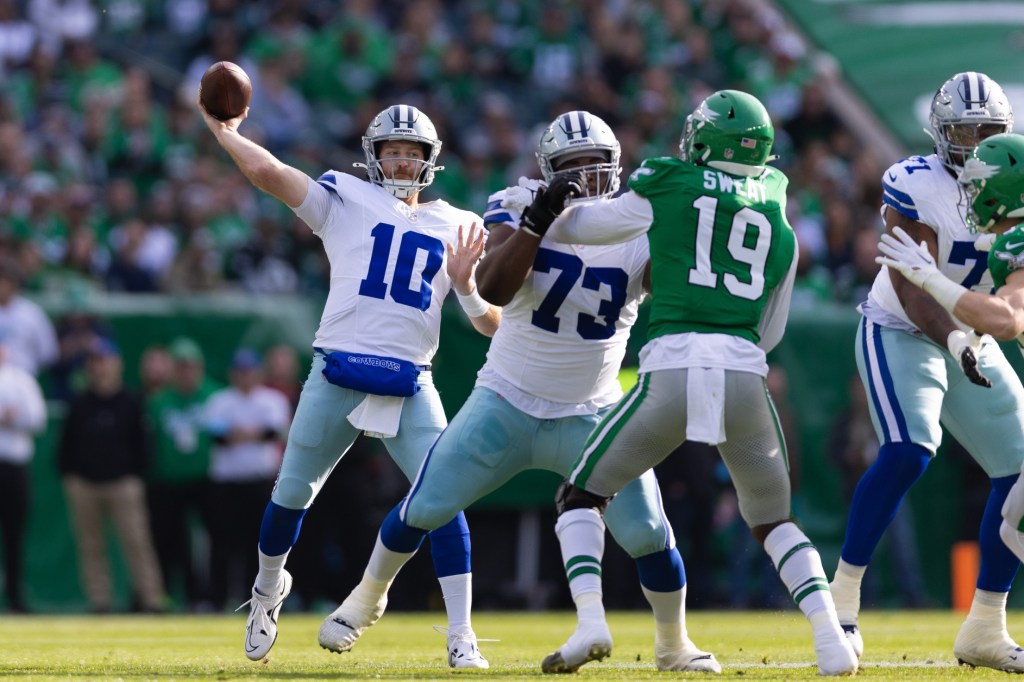Sideline collisions with players are a long-standing hazard for football coaches and staff. Tom Coughlin alone was bowled over at least three times in his 25-plus-year NFL career, including one serious injury in 2011.
Far less familiar to the game is the idea of insuring oneself against such field-adjacent endangerments. As far as anyone can tell, it’s never been an option.
Enter Rich “Big Daddy” Salgado. The Maryland lineman-turned–insurance salesman is somewhat of a legendary figure within NFL circles, where he’s known for his aggressive networking. At the recent NFL owners meeting in Orlando, for example, Salgado held court in the lobby of the Ritz-Carlton, eagerly slapping hands with head coaches and team officials, handing out flyers for his June golf fundraiser and pushing a new product.
For the past quarter century, Salgado, 59, has sold liability and other insurances to, by his count, 500-plus athletes, team officials, agents, and broadcasters, including the likes of Jay Glazer, Michael Strahan, John Dorsey, Reggie Bush, and Adam Schefter. But sideline-injury insurance? That’s a new one.
“A lot of guys look at you like you have two heads,” Salgado says of promoting the new policy, which to his knowledge has never been offered. “Some guys say, ‘Man, if I don’t have enough [insurance] from what I’m getting, then something’s wrong with me.’” (At least one competitor, Eugene Dorfman, the founder of Pro Player Insurance, doesn’t get it: A coach, he points out, could just get a Total and Permanent Disability policy.)
And still Salgado feels he’s onto something, especially at a time when the average NFL head coach is contracted to earn upward of $6 million per year. Since Salgado took the idea to market last year, he says he’s already sold a policy to one NFL head coach, and he believes he’s soon to wrap up a deal with a team executive who runs a major stadium.
An obvious question here might be: Wouldn’t a team cover its coach if they were severely injured enough to retire, costing them future earnings and thus justifying a policy? Salgado explains that this is no different than an individual who receives minimal disability insurance through work, but in this hypothetical we’re talking about a head coach who stands to lose tens of millions of dollars in future compensation. “When you own your own policy, compared to something that is given to you through an organization—a business, a team—some people may feel [the latter] isn’t enough [coverage],” Salgado says.
Lloyd’s of London underwrites Salgado’s new sideline offering, with the U.K.-based insurer assessing the risk and price of a policy by analyzing the number of collisions on sidelines and how often people are injured. The cost to the insured ultimately depends on how much coverage a person wants, but an annual premium will typically price out above $10,000.
Salgado says he’s primarily targeting head coaches, as opposed to assistants or any of the scores of people who populate sidelines—photographers, reporters, cheerleaders, first-down marker holders—but who are unlikely to earn enough to warrant a disability contract, which pays out a percentage of earnings.
So, really, how likely is a head coach to be rolled badly enough to be forced into retirement, justifying a policy? Dorfman, Salgado’s competitor in the field, suggests such injuries are too rare to account for, even if YouTube offers a testament to the dangers.
“Sometimes … you just can’t get out of the way and you get rolled up,” Salgado says. “And what happens if you break a leg, blow a knee … [and] you get an infection from that injury? … You’re done.”
Salgado next heads to the draft in Detroit, where he’ll try to sell rookies on insuring their futures—but once training camps open he’ll turn his attention again to the sidelines, pointing out—he says—the dangers of being an observer.

















